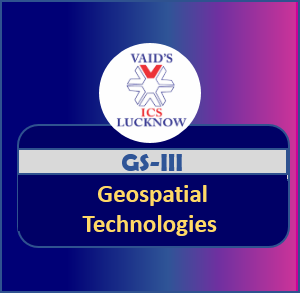CURRENT AFFAIRS
Get the most updated and recent current affair content on Padhaikaro.com
Geospatial Technologies
- Vaid's ICS, Lucknow
- 27, Jul 2021

Why in News?
Recently, a report on opportunities from the use of Geospatial Technologies in the Water Sector was released by the Director General, National Mission for Clean Ganga.
About
- This Report was prepared by the Association of Geospatial Industries – a geospatial technology industry body.
- The report provides an overview of how each of these programmes is currently using geospatial technologies, and how to improve technology adoption in the future.
- Various programmes like Jal Jeevan Mission, Atal Bhujal Yojana, have been set up using these technologies.
Major Highlights from the Report
- As a fast developing and second most populous country in the world, India is facing a severe water crisis that is becoming a critical issue.
- Home to about 17% of the world population, and around 20% of world’s livestock population, India has access to only about 4% of the world’s freshwater reserves.
Key Concerns or Indian Water Sector:
Rain water and Glaciers:
India receives 3,000 billion cubic metres of water every year through rainfall or other sources such as glaciers; of this, only 8% is collected.
Ground Water:
- Rate of extraction of Groundwater in India is higher than Rate of filling the aquifers.
- 89% of India’s water resources are used for agriculture, out of which 65% is withdrawn from under the ground.
- Industry too obtains around 80% of their water requirements from underground sources. Thus, one of India’s biggest challenges is to conserve groundwater.
Water Storage Capacities:
- India also has insufficient water storage capacities.
- While some countries have capacities up to 5000 mt cube per person storage infrastructure, India only has about 200 mtr cube per person.
- This results in droughts even in years that experience good monsoons.
Water Quality:
- Even the water that is available is not fit for direct consumption. Groundwater in one-third of India’s 600 districts is contaminated mainly through fluoride and arsenic.
- India’s economic burden through water borne diseases is approximately USD 600 million a year.
- Less than 50 percent of India’s population has access to safe managed drinking water, and that too is inequitable.
Water Resources Management:
- The science in water resources management is very complex and dynamic.
- The implication of an applied strategy is not known in the short run.
- The gestation period for any quantifiable change is upwards of a decade, hence adoption of appropriate technology tools and analytics to assess the situation and simulate various possibilities is critical
- for sustainable development in the water sector.
GeoSpatial Technologies in India
- Geospatial Technologies are tools that enable us to present the spatial context of phenomena and provide a platform for developing an understanding of ‘what-if’ scenarios by integrating various other datasets.
- The term ‘geospatial’ refers not to one single technology, but a sleuth of technologies that help to collect, analyse, store, manage, distribute, integrate, and present geographic information.
It consists of the following technologies:
Remote Sensing:
- This technology allows us to remotely capture features of Earth’s surface by using various sensors that are typically mounted on satellites or airborne vehicles.
- Remote Sensing sensors record earth’s reflectance in different wavelengths, and these received reflectance values are processed to create a separate image for each wavelength.
- The reflectance value is stored for different wavelengths in different layers, which are also called bands present in that satellite image.
- A sensor can record several wavelengths simultaneously. In general, there are three wavelengths from visible i.e. blue wavelength, green wavelength and red wavelength, whereas infrared can be further defined as near infrared, mid infrared, far infrared and thermal infrared.
- Multispectral satellite data for the water sector is extremely useful as it helps extract detailed information and facilitates more accurate interpretation and classified thematic maps.
It helps in:
- assessing depth
- water turbidity
- understanding aqua culture
- assessing water levels
- river movement
- understanding water-related disaster scenarios,
- overview of population spread etc.
Surveying:
- This technology is used to make relatively large-scale, accurate measurements of the Earth’s surface.
- Surveying has two similar but opposite functions:
- The determination of existing relative horizontal and vertical position, such as that used for the process of mapping, and
- The establishment of marks to control construction or to indicate land/water boundaries.
- Survey equipment include theodolite, total station, 3D scanners, LiDAR etc.
Global Navigation Satellite System (GNSS):
- Global Navigation Satellite System (GNSS) provides precise position or geographic location of people, equipment or things that are attached to a device that includes a GNSS chip.
- Data about the location is gathered from a constellation of navigation satellites that cover the entire globe.
- Common applications include navigation, and routing.
- GNSS is also used in high precision construction.
Geographic Information System (GIS):
- A Geographic Information System (GIS) is a conceptualized framework that provides the ability to capture and analyse spatial and geographic data.
- GIS helps integrate different data layers for enabling spatial based decision making for a variety of users from local governments, transport/logistics, insurance, environment monitoring, telecommunications etc.
Facts for Prelims:
SMILE (Support for Marginalized Individuals for Livelihood and Enterprise) Scheme:
- It is formulated by the Ministry of Social Justice and Empowerment which includes a subscheme – ‘Central Sector Scheme for Comprehensive Rehabilitation of persons engaged in the act of Begging’.
Key Points
- The scheme covers several comprehensive measures including welfare measures for persons who are engaged in the act of begging.
- The focus of the scheme is extensively on rehabilitation, provision of medical facilities, counseling, basic documentation, education, skill development, economic linkages and so on.
- The scheme would be implemented with the support of State/UT Governments/Local Urban Bodies, Voluntary Organizations, Community Based Organizations (CBOs) , institutions and others.